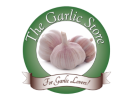Storing Garlic
First a word of caution: NEVER allow garlic in oil to sit at room temperature. It is a hotbed for botulism. Keep it refrigerated or frozen at all times.
Fresh garlic kept in a dry, dark, cool place will keep for a long time. Some use special containers for storing garlic. A pretty garlic keeper in your kitchen is a cheerful decorating item, but garlic can also be kept in something as simple as a brown paper bag. Just never keep your garlic in your refrigerator. It will sprout and become bitter. If you don't use that much garlic and know that the bulb will be sitting there for a long time, it is better to freeze it or store it by one of the many methods described below.
There are lots of other ways to store garlic.
What some people do in order to make them last is cutting them up into thin slices and then drying them. You can get food driers at places like Walmart. The sliced garlic can be reconstituted by adding them to a pot or casserole.
You may also grind the dried slices into powder.
Pureeing is another good method to preserve garlic and always have fresh garlic at hand. Puree in a blender or food processor and freeze. Personally, I prefer the garlic not as a puree, but in small pieces. Using a food processor, I simply pulse until the garlic pieces are the size I want, making sure that I don't place too much garlic in the processor at a time in order to avoid too great variation in the size of the pieces or the garlic turning to mush.
Some then wrap the chopped garlic in small packets of plastic and freeze them. You can also add oil to the garlic mixture, 1 part garlic to 2 parts oil, and freeze it in a container or - as I prefer - in ice cube trays. That makes it easy to pop out the garlic you need.
Some microwave unpeeled cloves for about 30 seconds and freeze them in plastic wrap or a freezer bag.
Some freeze whole heads and tear off cloves as needed, but personally I find that this alters the flavor too much.
I prefer storing peeled garlic cloves in oil and keeping them in the freezer, as freezing raw, unprotected garlic greatly changes its flavor and texture.
If you prefer to keep your garlic in the refrigerator, submerge the garlic cloves in wine instead of oil. Dr. George York, University of California at Davis has provided this method for acidifying garlic in order to make it safe: Cover peeled garlic cloves with vinegar and soak the cloves for 12 to 24 hours. Drain off the vinegar. It may be reused as garlic-flavored vinegar. Cover the garlic cloves with oil. Refrigerate the garlic/oil and use within 3 months.
You may also mix pureed or minced garlic with butter (about 5-6 cloves per stick of butter), shape the mixture into a log rolled in wax paper and freeze, tightly wrapped in plastic. You can then cut off pieces as needed to enhance a steak, drop it into a soup or sauce, or use for sautéing. Just make sure that you use it before the butter goes rancid.
